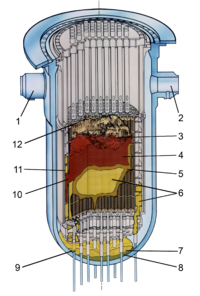
Photo from wikipedia
Abstract The solidification phases of molten core–concrete under the estimated molten core–concrete interaction (MCCI) conditions in the Fukushima Daiichi Nuclear Power Plant Unit 1 were predicted using the thermodynamic equilibrium… Click to show full abstract
Abstract The solidification phases of molten core–concrete under the estimated molten core–concrete interaction (MCCI) conditions in the Fukushima Daiichi Nuclear Power Plant Unit 1 were predicted using the thermodynamic equilibrium calculation tool, FactSage 6.2, and the NUCLEA database in order to contribute toward the 1F decommissioning work and to understand the accident progression via the analytical results for the 1F MCCI products. We showed that most of the U and Zr in the molten core–concrete forms (U,Zr)O 2 and (Zr,U)SiO 4 , and the formation of other phases with these elements is limited. However, the formation of (Zr,U)SiO 4 requires a relatively long time because it involves a change in the crystal structure from fcc-(U,Zr)O 2 to tet-(U,Zr)O 2 , followed by the formation of (Zr,U)SiO 4 by reaction with SiO 2 . Therefore, the formation of (Zr,U)SiO 4 is limited under quenching conditions. Other common phases are the oxide phases, CaAl 2 Si 2 O 8 , SiO 2 , and CaSiO 3 , and the metallic phases of the Fe–Si and Fe–Ni alloys. The solidification phenomenon of the crust under quenching conditions and that of the molten pool under thermodynamic equilibrium conditions in the 1F MCCI progression are discussed.
Journal Title: Journal of Nuclear Materials
Year Published: 2017
Link to full text (if available)
Share on Social Media: Sign Up to like & get
recommendations!